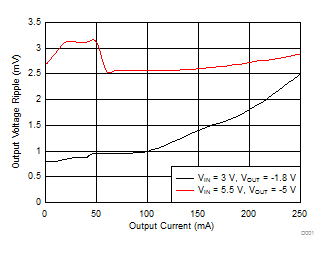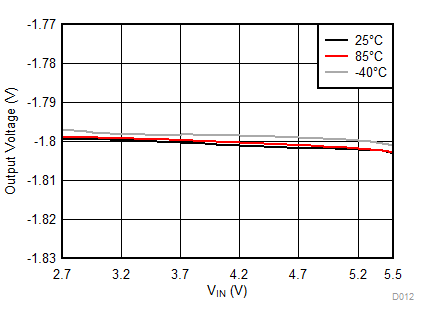ZHCSEO7C October 2015 – January 2017 LM27761
PRODUCTION DATA.
- 1 特性
- 2 应用
- 3 说明
- 4 修订历史记录
- 5 Pin Configuration and Functions
- 6 Specifications
- 7 Detailed Description
-
8 Application and Implementation
- 8.1 Application Information
- 8.2
Typical Application - Regulated Voltage Inverter
- 8.2.1 Design Requirements
- 8.2.2 Detailed Design Procedure
- 8.2.3 Application Curves
- 9 Power Supply Recommendations
- 10Layout
- 11器件和文档支持
- 12机械、封装和可订购信息
6 Specifications
6.1 Absolute Maximum Ratings
over operating free-air temperature range (unless otherwise noted)(1)(2)| MIN | MAX | UNIT | ||
|---|---|---|---|---|
| Ground voltage, VIN to GND or GND to VOUT | 5.8 | V | ||
| EN | (GND − 0.3 V) | (VIN + 0.3 V) | ||
| Continuous output current, CPOUT and VOUT | 300 | mA | ||
| TJMAX(3) | 150 | °C | ||
| Storage temperature, Tstg | –65 | 150 | °C | |
(1) Stresses beyond those listed under Absolute Maximum Ratings may cause permanent damage to the device. These are stress ratings only, which do not imply functional operation of the device at these or any other conditions beyond those indicated under . Exposure to absolute-maximum-rated conditions for extended periods may affect device reliability.
(2) If Military/Aerospace specified devices are required, contact the TI Sales Office/Distributors for availability and specifications.
(3) The maximum power dissipation must be de-rated at elevated temperatures and is limited by TJMAX (maximum junction temperature), TA (ambient temperature) and RθJA (junction-to-ambient thermal resistance). The maximum power dissipation at any temperature is: PDissMAX = (TJMAX – TA)/RθJA up to the value listed in the Absolute Maximum Ratings.
6.2 ESD Ratings
| VALUE | UNIT | |||
|---|---|---|---|---|
| V(ESD) | Electrostatic discharge | Human-body model (HBM), per ANSI/ESDA/JEDEC JS-001(1) | ±1000 | V |
| Charged-device model (CDM), per JEDEC specification JESD22-C101(2) | ±250 | |||
(1) JEDEC document JEP155 states that 500-V HBM allows safe manufacturing with a standard ESD control process.
(2) JEDEC document JEP157 states that 250-V CDM allows safe manufacturing with a standard ESD control process.
6.3 Recommended Operating Conditions
over operating free-air temperature range (unless otherwise noted)| MIN | MAX | UNIT | ||
|---|---|---|---|---|
| Operating ambient temperature, TA | –40 | 85 | °C | |
| Operating junction temperature, TJ | –40 | 125 | °C | |
| Operating input voltage, VIN | 2.7 | 5.5 | V | |
| Operating output current, IOUT | 0 | 250 | mA | |
6.4 Thermal Information
| THERMAL METRIC(1) | LM27761 | UNIT | |
|---|---|---|---|
| WSON (DSG) | |||
| 8 PINS | |||
| RθJA | Junction-to-ambient thermal resistance | 67.7 | °C/W |
| RθJC(top) | Junction-to-case (top) thermal resistance | 89.9 | °C/W |
| RθJB | Junction-to-board thermal resistance | 37.6 | °C/W |
| ψJT | Junction-to-top characterization parameter | 2.4 | °C/W |
| ψJB | Junction-to-board characterization parameter | 38 | °C/W |
| RθJC(bot) | Junction-to-case (bottom) thermal resistance | 9.4 | °C/W |
(1) For more information about traditional and new thermal metrics, see Semiconductor and IC Package Thermal Metrics.
6.5 Electrical Characteristics
Typical limits apply for TA = 25°C, and minimum and maximum limits apply over the full temperature range. Unless otherwise specified, VIN = 5 V and values for C1 to C4 are as shown in the 典型应用.| PARAMETER | TEST CONDITIONS | MIN | TYP | MAX | UNIT | |
|---|---|---|---|---|---|---|
| Iq | Supply current | Open circuit, no load | 370 | 600 | µA | |
| ISD | Shutdown supply current | 7 | 12 | µA | ||
| ƒSW | Switching frequency | VIN = 3.6 V | 1.7 | 2 | 2.3 | MHz |
| RNEG | Output resistance to CPOUT | VIN = 5.5 V | 2 | Ω | ||
| VDO | LDO dropout voltage | ILOAD = 100 mA, VOUT = −5 V | 30 | mV | ||
| PSRR | Power supply rejection ratio | ILOAD = 80 mA, VCPOUT = −5 V | 35 | dB | ||
| VN | Output noise voltage | ILOAD = 80 mA, 10 Hz to 100 kHz | 20 | µVRMS | ||
| VFB | Feedback pin reference voltage | 1.202 | 1.22 | 1.238 | V | |
| VOUT | Adjustable output voltage | 5.5 V ≥ VIN ≥ 2.7 V | –5 | –1.5 | V | |
| Load regulation | 0 to 250 mA, VOUT = −1.8 V | 4.6 | µV/mA | |||
| Line regulation | 5.5 V ≥ VIN ≥ 2.7 V, ILOAD = 50 mA | 1.5 | mV/V | |||
| VIH | Enable pin input voltage high | 5.5 V ≥ VIN ≥ 2.7 V | 1.2 | V | ||
| VIL | Enable pin input voltage low | 5.5 V ≥ VIN ≥ 2.7 V | 0.4 | V | ||
| UVLO | Undervoltage lockout | VIN falling | 2.6 | V | ||
| VIN rising | 2.4 | |||||
6.6 Typical Characteristics
Unless otherwise specified, TA = 25°C, VIN = 5 V, and values for C1 to C4 are as shown in the 典型应用.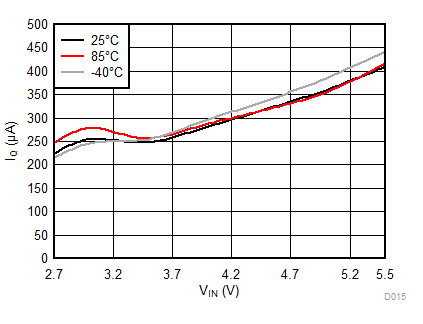
| EN = 1 | ILOAD = 0 mA |
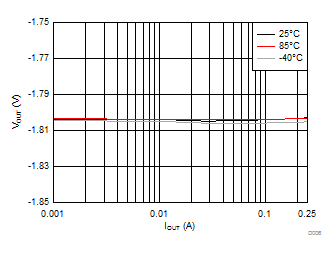
| VIN = 3 V | VOUT = –1.8 V | |
| R1 = 237 kΩ | R2 = 500 kΩ |
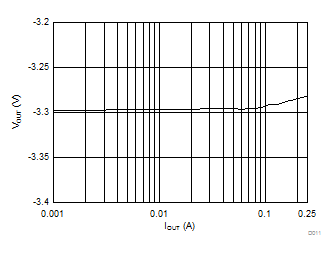
| VIN = 5 V | VOUT = –3.3 V | |
| R1 = 856 kΩ | R2 = 500 kΩ |

| VIN = 5.5 V | VOUT = –5 V | IOUT = 250 mA |
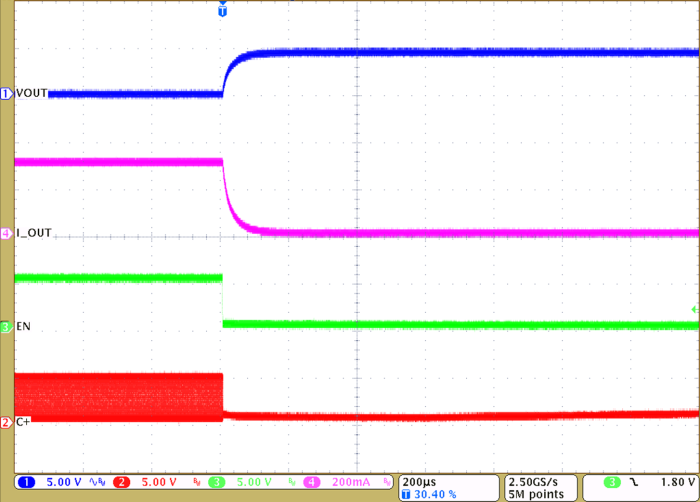
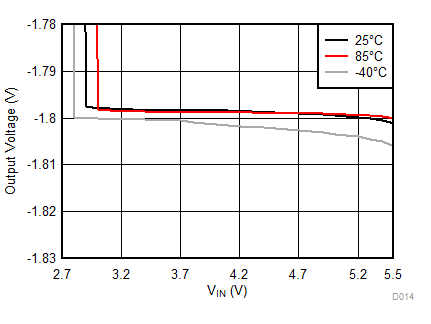
| VOUT = –1.8 | IOUT = 250 mA | R1 = 237 kΩ | R2 = 500 kΩ | |
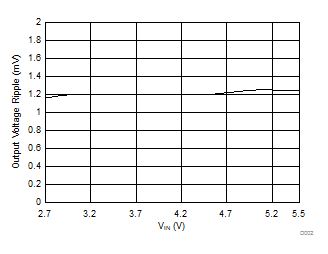
| VOUT = –1.8 V | IOUT = 100 mA |
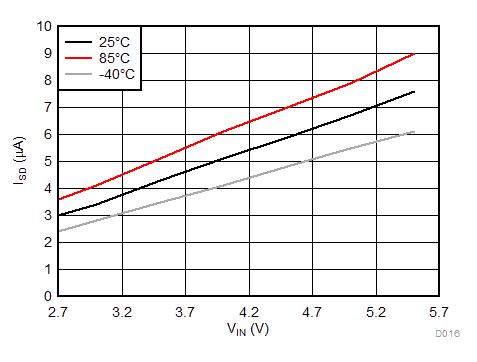
| EN = 0 |
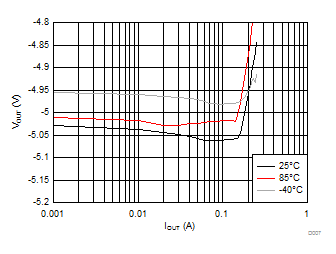
| VIN = 5.5 V | VOUT = –5 V | |
| R1 = 1.54 MΩ | R2 = 500 kΩ |

| VIN = 3 V | VOUT = –1.8 V | IOUT = 250 mA |
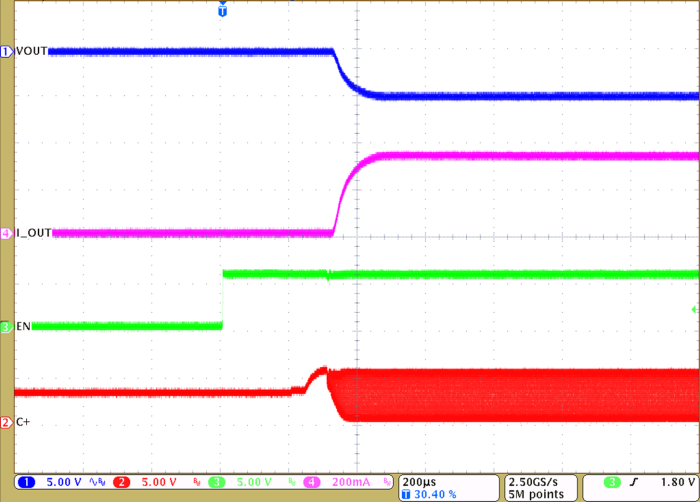
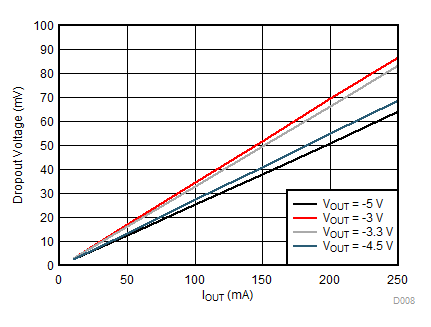
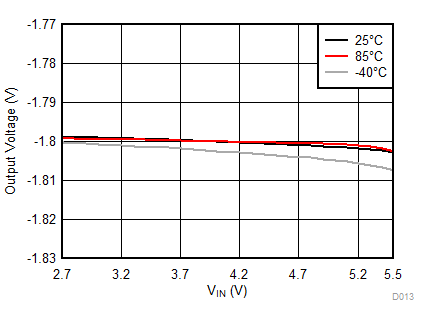
| VOUT = –1.8 V | IOUT = 100 mA | |
| R1 = 237 kΩ | R2 = 500 kΩ |
